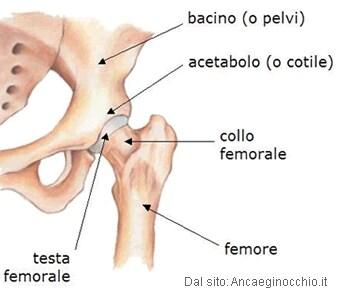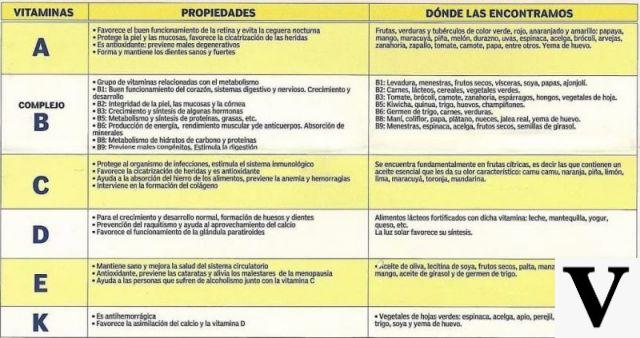generality
La hip replacement it becomes necessary when the joint, which unites the femur and acetabulum, is seriously damaged. In such circumstances, the application of the prosthesis aims to restore normal joint mobility, which would otherwise be irremediably compromised.
The operation is invasive and requires careful rehabilitation, but the results are more than satisfactory: the patient, in fact, returns to lead a normal life, without particular limits.
There are different models of hip prostheses: what varies are the material of construction and the methods of application. Medical research aims to extend the life of the prostheses, to preserve them from the wear of time and to reduce the invasiveness of the intervention.
Brief anatomical reference: the hip
The term anca identifies both the anatomical region of the human body that connects the trunk to the lower limbs, and the joint that resides in this position. L'hip joint, or more simply hip, is made up of a skeletal scaffold held together by different muscles and ligaments.
The bones, which form the hip joint, are:
- The root (or proximal part) of the femur, consisting of forehead and from neck below
- L'acetabolo, a cavity in which the head of the femur is placed
 The hip is one of the largest joints in the human body and belongs to the family of enarthrosis. In enarthrosis, a convex bone portion lodges in a concave bone portion; this structure, together with the ligaments that surround it, allows a wide mobility, superior to that of the other types of joints.
The hip is one of the largest joints in the human body and belongs to the family of enarthrosis. In enarthrosis, a convex bone portion lodges in a concave bone portion; this structure, together with the ligaments that surround it, allows a wide mobility, superior to that of the other types of joints.
To reduce friction and impact shocks, the hip joint is surrounded by synovial fluid and cartilage. If it were without it, the bone surfaces would deteriorate, due to the continuous rubbing between them.
The hip is essential, as it allows the man to stand upright, to walk, to run, etc.
When is it necessary to intervene?
Like any joint, the hip can also be damaged. When this happens, the first therapeutic measure is conservative treatment (rehabilitation, physiotherapy and pain relievers). However, if the extent of the damage is substantial or chronic in nature, serious consideration should be given to undergoing surgical intervention. hip replacement. In these cases, it is persistent pain and the inability to perform the easier daily activities (standing, walking, driving, etc.) that persuade the patient to have surgery.
The hip prosthesis replaces the natural joint, which is no longer functional.
MORE CAUSES ?? FREQUENT JOINT DAMAGE
There are three common causes of hip joint damage:
- Osteoartrosi. They are the most common osteoarthritis, characterized by the consumption (by continuous rubbing) of the articular cartilage. For this reason, they are also called "wear-and-tear osteoarthritis". The patient, usually elderly, experiences pain and motor difficulties.
- Rheumatoid arthritis. It is an autoimmune disease, in which the immune system, rather than defending the body from infection, "turns" against it. Joints pay the consequences: they become stiff, painful and swollen.
- Bone fracture. Hip fractures are one of the most common bone fractures in older people. Spontaneous healing is sometimes not enough to restore full joint mobility.
OTHER CAUSES
At the origin of a hip damage, there may also be other causes, less common than the previous ones. One of these is theseptic arthritis, which is bacterial inflammation of the joint. Another is the avascular necrosis, due to alcohol abuse. Still another is there Paget's disease of bone, which impairs bone growth and turnover. The bones become more fragile and are at ongoing risk of fracture.
Finally, there are the bone tumors and congenital dysplasia of the hip. The latter, in particular, is characterized by an anomalous arrangement of the articular bone elements, which affects the mobility of the joint. The disorder is present from birth and sometimes has disabling effects.
WHO UNDERGO THE INTERVENTION?
The individuals who undergo the most hip replacement surgery are the elderly between the ages of 60 and 80. This is in line with what has just been said regarding the main causes of joint damage in the hip. In fact, osteoarthritis, rheumatoid arthritis and hip fractures are pathological conditions typical of old age.
Intervention on young adults and children is rare. The most frequent cause in these situations is congenital hip dysplasia.
WHAT ARE THE BENEFITS OF THE INTERVENTION?
Hip replacement surgery aims to achieve the following objectives and benefits:
- Pain reduction
- Improvement of joint mobility
- Improvement of the motor skills of the operated individual
- Significant improvement in the quality of life
How is the surgery performed? The procedure
A brief introduction must be made. There are three types of hip replacement surgery. However, in this article, only one type will be dealt with in detail, namely the one that involves the replacement of the entire hip joint and a large part of the femur. The reason is simple: while it is the most invasive surgery, it provides the best results.
The other two methods will be briefly illustrated in the chapter dedicated to alternative interventions.
ANESTHESIA
Hip replacement surgery is usually performed in general anesthesia. However, it is also possible to opt for a 'epidural anesthesia, in which only the lower body is numb to pain. Those who choose this second option, however, are not conscious, since they must take strong sedatives.
THE REAL PROCEDURE
After the anesthesia has taken place, the actual surgery begins. The procedure lasts between 60 and 90 minutes and can be divided into three key moments:
- Hip incision
- Removal of the damaged joint
- Replacement with an artificial joint
When the damaged joint is removed, the upper part of the femur (head, neck and a piece of the body) and the portion of the acetabulum, in which the femur itself is housed, are removed.
Only at this point, the replacement of the hip with a metal alloy prosthesis is carried out. The surgeon begins by attaching an artificial cavity to the pelvis, which acts as an acetabulum. This cavity is called cup (o turn) prosthetic. Next, apply the so-called prosthetic stem. One end of the stem is made to fuse to the remaining femur; the other end has a head, very similar to that of the femur, which fits perfectly inside the prosthetic cup.
Finally, to firmly fix the cup and the head of the stem, there are two solutions: either you apply acrylic cement (a kind of glue), or you use a pressure mechanism.
USED MATERIALS
The hip prosthesis is made of different materials. The stem and cup are of a metal alloy; the insert and the head, on the other hand, can be made of plastic or ceramic as well as metal. The materials of construction affect the durability and wear of the prosthesis.
The following table shows the possible materials with which to build the various parts of the prosthesis, and the possible associations between head and insert.
| Parts of the prosthesis | Materials |
| Cup | Titanium |
| Insert |
polyethylene Ceramic Metal |
| Stud | Titanium alloy |
| Head |
Chromium - cobalt - molybdenum alloy Ceramic |
| Possible associations between head / insert |
Metal / polyethylene Ceramic / polyethylene Ceramics / ceramics Metal / metal |
There are two strategies for welding the stem to the femur.
The first involves the use of an adhesive, the acrylic concrete. The weld created is very strong, so much so that the removal of the prosthesis, when it has worn out, is difficult and becomes a problem. This option is known as cemented prosthesis.
The second strategy, on the other hand, consists in creating, first of all, a housing, in the femur, perfect for the stem; and then inserting the latter with a pressure mechanism. When opting for this type of weld (known as cementless prosthesis), prostheses are used, the stem of which has very small holes. The holes allow the bone to grow inside, further anchoring the prosthesis. The advantages of the cementless prosthesis are the easy removal.
CHOICE OF THE PROSTHESIS
There are more than 60 different models of hip replacements. However, fewer than ten are actually used. The choice of the most appropriate prosthesis is up to the surgeon, who from time to time makes various considerations relating to:
- Age of the patient
- Body weight and fragility of some materials (ceramic)
- Possible allergies of the patient to the materials (metals) of the prosthesis
- Gender
- Basic pathology
Given its importance, theage of the patient deserves special attention. An elderly patient has no particular needs: the prosthesis may not be the longest-lived and not even of the non-cemented type. This is because it is unlikely that you will undergo a second surgery to replace the worn prosthesis.
Conversely, however, a young patient needs a durable and, possibly, non-cemented prosthesis. In this way, in addition to postponing the replacement operation as much as possible, it also makes it easier to carry out.
Post-operative course, risks of the intervention, alternative interventions "


























